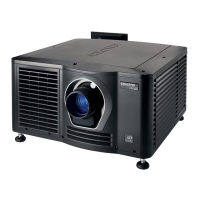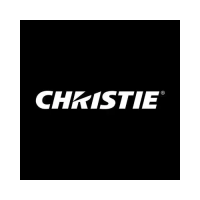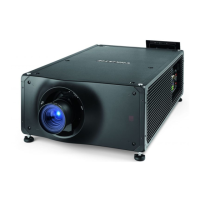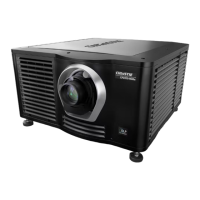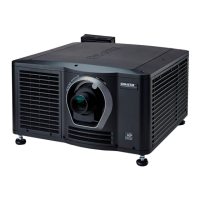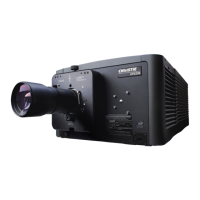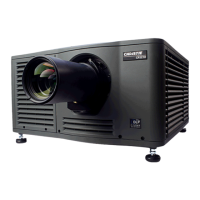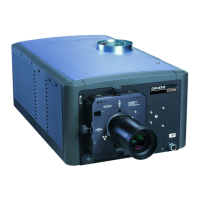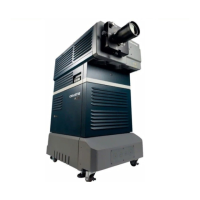Do you have a question about the Christie CP2308-G and is the answer not in the manual?
Statement regarding the CP2308-G subassembly's functional status and regulatory compliance.
Guidelines for safe installation and operation, including electrical, fire, and physical hazards.
Precautions for operating the projector light source safely, avoiding eye damage.
Safety guidelines for connecting and using AC power, including grounding and voltage requirements.
Information about hazard labels used on the product, including color and placement.
Hazard warnings related to accessories and general risks like electric shock, heat, and explosions.
Mandatory safety actions like disconnecting power and consulting the service manual.
Indicates the presence of an earth ground connection for safety.
Mentions related hazard labels for thermal and optical risks on the end product.
Instructions on how to access installation, setup, and user information from the Christie website.
List of additional documents providing further information on the product.
Description of the Christie CP2308-G as a compact 3DLP cinema projector with enhanced functionality.
Guidance on recording installation information and contacting a dealer for assistance or service.
Highlights of the projector's important features, including playback, touch panel, and connectivity.
Explanation of the touch panel interface, its menus, and controls for projector operation.
Instructions for powering the projector on to display content or off to conserve energy.
Steps to log into the projector to access menus and settings using user credentials.
Procedure to log out to restrict access to projector menus or change permissions.
How to turn the touch panel on for menu access or off to conserve energy.
Steps to calibrate the touch panel for improved appearance and responsiveness.
How to turn the light source on for display or off to extend the life of the lasers.
Procedure to open the douser to display light or close it to remove light from the screen.
How to create channels for customized projector settings for different inputs.
Steps to add an NTP server for synchronizing time across projectors in the same region.
How to remove an NTP server if time synchronization is no longer needed.
Procedure to adjust time zone settings to match the local time zone.
How to select between 12-hour or 24-hour format for displaying projector time.
How to set the projector to automatically adjust for Daylight Saving Time.
Steps to manually adjust the time offset when NTP synchronization is inactive.
Procedure to complete marriage for displaying content and complying with DCI specification.
How to change image orientation for multi-projector installations using deflection mirrors.
Steps to change the projector's host name for easier identification.
How to set the touch panel to display temperatures in Celsius or Fahrenheit.
Table listing default permissions for Installer, Manager, Operator, and Service user roles.
Steps to create new user accounts with specific names, permissions, and passwords.
How to modify user account permissions to limit or increase access to menus and functionality.
Procedure to periodically change user account passwords for authorized access.
Steps to delete user accounts to prevent access to projector menus and functionality.
How to connect the projector to the theater network for remote control and communication.
Steps to connect a NAS device for ingesting and playing content.
How to connect the projector to a media or content network to play content.
Procedure to activate SNMP for monitoring the theater network for failures.
How to download MIB files containing definitions for SNMP-managed devices.
Options for setting the type of integrated media block (IMB) used with the projector.
Steps to install the IMB and complete marriage for secure content display.
Explanation of icons used in the content manager to identify content types and features.
Procedure for ingesting content and keys from an ingest device to the projector.
How to cancel an ingest operation if it is taking too long or has been done before.
How to check the remaining NAS storage capacity to determine if more storage is needed.
Steps to filter content by type to locate specific content or reduce results.
How to view available keys required for playing encrypted content.
Procedure to filter the key list to locate specific types of keys.
How to delete local content to free up storage space on the projector.
Steps to delete keys when they expire.
How to adjust column visibility in the content manager to display more or less information.
How to view detailed information about selected content in the Properties panel.
Procedure for loading content onto the projector and starting playback.
How to unload content when it has finished playing and is no longer required.
Steps to create a new playlist with content files and automated events.
How to change the order of content or macros within a playlist.
Procedure to add a time offset to a macro within a playlist to control its playback timing.
How to replace existing content in a playlist with new content.
Steps to remove content from a playlist when it's no longer needed.
How to quickly create a new playlist by copying an existing one.
How to open an intermission playlist from a top-level playlist.
How to view detailed information about the content within a playlist.
Procedure to import playlists from other projectors or computers.
How to export playlists to other projectors or computers on the network.
Steps to delete a playlist that is no longer required or has expired.
How to create a channel for input devices connected to the HDMI port.
Steps to create a channel for input devices connected to the Integrated Media Block (IMB).
How to edit channel settings when input device parameters change.
Procedure to create a new channel with settings copied from an existing one.
How to change the active channel using the projector's touch panel.
How to view a list of all available channels on the projector.
Procedure to reorder channels in the list for easier access.
Steps to delete a channel when its input device settings are no longer needed.
How to create Measured Color Gamut Data (MCGD) files to correct on-screen colors.
Procedure to edit MCGD files when on-screen color readings change.
How to create a new MCGD file by copying settings from an existing one.
Steps to delete a MCGD file when it is no longer required.
Procedure to create Target Color Gamut Data (TCGD) files for color management.
How to edit TCGD files when color readings change.
Procedure to create a new TCGD file by copying settings from an existing one.
Steps to delete a TCGD file when it is no longer required.
How to activate the ILS for automatic adjustment of the lens position.
Steps to create an ILS file to set X, Y, zoom, and focus positions of the lens.
Procedure to use Auto Calibrate to compensate for motor backlash and determine lens movement range.
How to edit ILS file settings when content requirements change.
Procedure to copy ILS file settings to a new ILS file.
Steps to delete an ILS file when it is no longer required.
How to use the Reset Lens feature to find home position flags for ILS compensation.
Steps to create source files for resolution, offset, and aspect ratio settings.
How to edit source file settings when input device settings change.
Procedure to copy source file settings to a new source file.
Steps to delete a source file when it is no longer required.
How to create screen files for display panel size and image cropping.
Procedure to edit screen file settings when image parameters change.
How to copy screen file settings to a new screen file.
Steps to delete a screen file when it is no longer required.
How to perform digital convergence to improve on-screen image quality.
Procedure to reset digital convergence settings to default when image parameters change.
How to adjust the image to correct keystone effect using electronic cropping or feet adjustment.
Steps to correct horizontal keystone issues in dual projector setups.
How to correct vertical keystone issues in dual projector setups.
Procedure to correct vignetting where the image is brighter at the center than the sides.
How to perform vertical boresight adjustment for focus issues not corrected by lens alignment.
Procedure for horizontal boresight adjustment when image focus is not uniform.
Guidance on correcting DMD convergence problems for misaligned colors.
How to align the fold mirror to correct images with missing or shadowy corners.
How to create MCGD files to correct on-screen colors using a colorimeter.
Procedure to conceal unused screen edges with top or side masking.
How to display test patterns to refine image adjustment and diagnose issues.
Procedure to turn off a test pattern once image adjustment is complete.
How to import custom test patterns to meet specific viewing environment requirements.
Steps to delete a test pattern that is no longer required.
How to schedule playlists and automated events to run automatically on specific dates and times.
Procedure to modify the run time and date of a scheduled event.
How to copy and paste an event to run at a different date and time.
Procedure to copy and paste an entire day of scheduled events to a new date.
How to move a scheduled event to a different date and time using cut and paste.
Steps to delete an individual scheduled event that is no longer required.
How to delete all scheduled events for a specific day.
Procedure to change the start day of the week for the scheduler.
How to turn off the scheduler when scheduled events should not run automatically.
Steps to add a new storage device for storing and playing content.
How to edit storage device settings when device or communication settings change.
Procedure to designate a storage device as the primary source of content.
Steps to delete a storage device when it is no longer required.
How to add a remote ingest source for uploading content from a remote storage device.
Procedure to edit settings for remote ingest sources when configurations change.
Steps to delete a remote ingest source when it is no longer required.
How to create 3D files for playing 3D content on single or multiple projectors.
Procedure to edit 3D files to match the settings of the 3D hardware.
How to create a new 3D file with similar settings by copying an existing one.
Steps to delete a 3D file when it is no longer required.
How to increase or decrease the global audio delay setting.
Procedure to adjust the audio output rate to match the audio device.
How to map DCP audio channels to AES outputs using the Channel Mapping tab.
Steps to enable Dolby Atmos for playing content with Dolby Atmos audio.
How to edit Dolby Atmos settings when device configurations change.
Procedure to disable Dolby Atmos when it is no longer required.
How to enable multiple projectors for displaying 3D or HDR content.
Steps to add a slave projector for displaying 3D or HDR content.
Procedure to enable content synchronization for Christie NAS devices on the master projector.
How to disable multi-projector settings when a projector is no longer needed.
Procedure to disable a slave projector when it is replaced or no longer required.
Steps to delete a projector from a multi-projector configuration.
List and description of macro actions available for controlling automated events.
List of available built-in commands for Christie ACT devices.
List of available built-in commands for JNIOR devices.
List of available built-in commands for Dolby CP650, CP750, and CP850 devices.
List of available built-in commands for SKA-3D devices.
Steps to create a macro to perform a specific list of actions.
How to run a macro to make the projector perform a list of actions.
Procedure to add an action item to a macro for additional functionality.
How to combine macros to complete complex sets of actions.
Steps to delete macros when they are no longer required.
How to add an automation device for remote control and communication.
Procedure to modify automation device settings when parameters change.
Steps to remove an automation device when it is no longer required or physically removed.
How to create new playlist triggers to activate an automation device in a playlist.
Procedure to edit playlist trigger settings to change behavior.
Steps to delete a playlist trigger when it is no longer required.
How to create a global trigger to output a macro, e.g., for fire alarm.
Procedure to edit global trigger settings to change behavior.
Steps to delete a global trigger when it is no longer required.
How to import a device library containing commands for controlling specific devices.
Procedure to view device libraries to check for network device compatibility.
Steps to delete a device library when it is no longer required.
How to import a license to activate a product enhancement.
Procedure to enable an enhancement after importing its license.
Steps to create a new backup file for restoring projector settings after a failure.
How to export backup files to another location for disaster recovery.
Procedure to import a backup file to restore projector settings.
How to locate backup files by sorting them by name or creation date.
Steps to delete a backup file if it is no longer required or uploaded in error.
How to add an upgrade package to upgrade the projector software.
Procedure to view a list of available upgrade files for installation.
Steps to install an upgrade package to update the projector software.
How to compare upgrade packages to view differences between them.
Steps to delete an upgrade package that is no longer required.
Procedure to restore projector settings from a previously created backup file.
How to restore factory default settings, which removes custom projector settings.
How to access projector system logs for fault identification and correction.
Procedure to run the projector interrogator to identify and correct projector faults.
How to download certificates to request Key Delivery Message (KDM) keys.
How to ensure proper airflow by checking vents and maintaining clearance around the projector.
Procedure for inspecting and cleaning optical components like the projection lens.
List of recommended tools for cleaning the projector's optics.
How to clean the projection lens only if absolutely required to avoid scratching.
Procedure for inspecting the card cage air filter monthly.
How to inspect the filter located behind the service access panel in the light engine compartment.
Steps for cleaning washable filters using vacuum, compressed air, or water.
Procedure for safely removing and installing the projector lens.
Topics covering common projector issues and their solutions, starting with functionality.
Resolution steps for when the projector fails to power on.
Resolution for issues where input devices cannot communicate with the projector.
Topics covering common display issues and their solutions.
Resolution steps for projected images that flicker, have shadows, or are dim.
Steps to resolve issues when the screen is blank despite the projector being on.
Resolution for images displaying artifacts like smearing or double image perception.
How to fix images that appear vertically stretched or squeezed.
Resolution for when the displayed image colors are not as expected.
List of safety standards and regulations the product conforms to.
Information on emissions and immunity standards related to electromagnetic compatibility.
Details on environmental regulations including RoHS, REACH, and WEEE directives.
Information on international requirements for packaging recycling marks.
| Type | DLP |
|---|---|
| Resolution | 1920 x 1080 |
| Contrast Ratio | 2000:1 |
| Technology | DLP |
| Projection Technology | DLP |
| 3D Capability | Yes |
| Warranty | 3 years |
| Lens Options | Interchangeable lenses |
